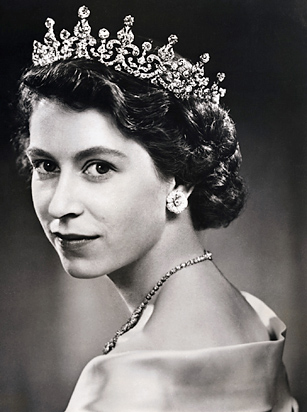
(2 of 2)
It was Reid who created the 1977 cover for the Sex Pistols single "God Save the Queen," which has become part of a robust body of work that defaces the Queen's image as shorthand for rebellion or antiestablishment passion. The British TV show Spitting Image, which aired 1984–'96, used puppets to mock the royals, making them look them dim or harried. In the late '90s, another show, The Royle Family, followed the escapades and interactions of a family that mirrored the Windsors in uncanny ways — right down to the fact that both clans lived off the government — except the Royles were broke.
More recently, the mock-the-Queen approach has fallen out of vogue, with such artists as Alison Jackson examining instead the strangeness of the public appetite for intimate or embarrassing details about the royal family. Jackson gets look-alike actors to pose as, say, the Queen sitting on the toilet reading a newspaper and photographs them in paparazzi style. The juxtaposition is uncomfortable, confronting readers with their own voyeurism: in a world full of artifice masquerading as reality, what images of the Western world's most gilded family do we seek out and create?
Perhaps the most interesting evolution of the Queen's cultural impact can be seen in the fashion industry. Her clothing choices, never considered avant-garde or even fashion forward, can be most generously described as safe. Under the risible headline "Elizabethan Look May Capture Fashion World," the Pittsburgh Press in February 1952 praised the Queen's fashion choices and her "dainty waist and slim hips" but noted that Norman Hartnell, one of the couturiers to the Crown, said that "no member of the royal family intends to influence fashion." If that was her aim, it has been one of the Queen's most successful and lasting campaigns.
The point of Her Maj's wardrobe is pretty much to wear what no one else will. She dons bright colors and bold prints so she can be easily spotted in a crowd. This tends to send the royal dresser to a lot of fuchsias, primrose yellows and purples — and so much the better if those colors aren't fashionable. Because she cannot under any circumstances be underdressed, the Queen will often wear matching hat, coat and gloves. For a long time this extreme matchiness was considered the leading edge of frumpiness. But over the years, the Queen's highly coordinated, color-saturated look has begun to appeal to other women, particularly those in positions of prominence without power. Michelle Obama wears similar hues and bright patterns. (Witness the matching yellow dress-and-coat ensembles she wore to her husband's Inauguration and Nobel Peace Prize ceremonies.) Carla Bruni, the First Lady of France, has regularly rocked blouses tied with a bow like those the Queen favors. The trickle-down effect has spilled over onto women who like to be contrary: über-hip British model Agyness Deyn cites the sovereign as her fashion icon. "The Queen dresses all matching," noted Japanese Vogue editor-at-large Anna Dello Russo. "What incredible impact that has. No one else dresses all in pink without looking hilarious, but she does. She pulls it off." Even the Queen's conspicuously dowdy casual wear, with its range of headscarves, wool skirts and knee socks, has been aped; it was the inspiration for Dolce & Gabbana's fall 2008 ready-to-wear line. All this must be very reassuring to a monarch in her twilight years. She doesn't have to change to keep up with the times. If she just stays as she is, the times will circle back to her.
In a new book from TIME, The Royal Family: Britain's Resilient Monarchy Celebrates Elizabeth II's 60-Year Reign, Europe editor Catherine Mayer and colleagues take a look at the Windsors and their legacy. Now available in bookstores, or go to www.time.com/royalsbook to order your copy today.